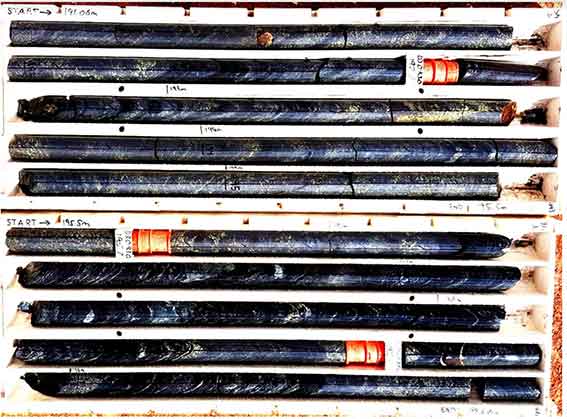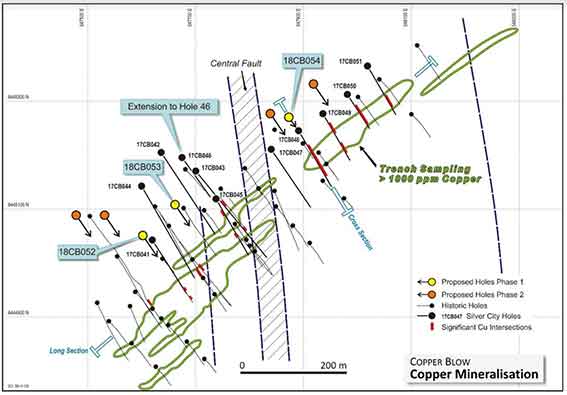Silver City strikes broad copper zone at Copper Blow
Mining
Mining
Silver City Minerals has struck a broad zone of copper that extends for about 50 metres down the hole at its Broken Hill Copper Blow project.
Drilling results from hole CB054 encountered a significant increase in sulphide content at about 180 metres down, of between 1 per cent and 10 per cent with the dominant sulphide being copper sulphide.
“The Company considers this to be a significant mineralised intersection. Geological interpretation suggests a steeply dipping, well mineralised shear zone approximately 50 metres in true thickness. It has a higher grade zone on the southeast (footwall) side which is approximately 30 metres in true thickness.,” the company told investors.
“The shear zone hosts continuous copper mineralisation from surface to at least 200 metres below surface and is open at depth.”
The copper mineralisation and associated gold and cobalt are characteristic of iron oxide copper-gold deposits (IOCG) such as those which occur in Queensland (Ernest Henry and Selwyn) and in South Australia (Olympic Dam and Prominent Hill).
These range in size from small high grade deposits at Tennant Creek to mega-deposits such as Olympic Dam (+10 billion tonnes) and are an import source of not only copper, but gold and uranium.

Recent drilling program
Silver City has just completed four drill diamond holes to test the extent and continuity of
mineralisation down dip and down plunge of existing copper and gold intersections.
Previous drilling delivered initial results that provided the company with several “high quality”
follow-up targets.
Copper Blow is located 20km south of Broken Hill, which is traditionally known for silver, lead
and zinc – but investigations by Silver City show this western NSW mining district also
contains an abundance of copper and gold.
On target
One of the holes drilled beneath an earlier drill hole that intersected two zones of high grade copper-gold mineralisation.
Prior drilling of these zones returned results of 4 metres at 6.1 per cent copper and 4.2 grams of gold per tonne, including 1 metre at 11.3 per cent copper and 10.7 grams of gold, and 2 metres at 2.4 per cent copper and 0.8 grams of gold.
The new hole was designed to test for deeper extensions to these zones and was drilled to 300.4 metres.
Geological interpretation suggests that the down-dip extensions of both zones were encountered.
The second hole, meanwhile, was drilled to 386 metres to test the continuity of grade between intersections in two historic holes that returned 11.8 metres at 6.7 per cent copper and 1.92 grams of gold and 19.2 metres at 1.8 per cent copper.
The hole encountered similarly broad zones of strong biotite-silica alteration, with vein clusters between 284 and 295 metres, 308 and 312 metres, 324 and 327 metres and 340 and 374 metres.
The third hole CB054, hit 50 metres of copper mineralisation in magnetite and the forth hole intersected an 11 metre wide magnetite, sulphide-bearing quartz vein.

Continued exploration
Silver City plans to initiate phase 2 of the drilling program as soon as possible.
No deep drilling has been undertaken in the northeast or southwest of zones outlined in recent holes, but early indications suggest equally large zones of copper and gold.
Detail ground geophysical surveys were completed in late 2017.
The surveys indicate that in addition to the North and South zones at Copper Blow, there are seven pod-like zones of coincident magnetic and gravity anomalies along a 4.5 kilometre prospective magnetic shear.
“The broad intersection of copper mineralisation in hole 18CB054 located north of the
Central Fault highlights the strong relationship between magnetite and sulphide mineralisation,” Silver City said.
The most intense magnetic-gravity anomaly is about 400 metres long and at surface hosts old mine workings.
Silver City says it has the potential to host significant copper, but it hasn’t been tested yet .
The Phase 2 program will systematically test these initially with reverse circulation drilling.
This special report is brought to you by Silver City Minerals.
This advice has been prepared without taking into account your objectives, financial situation or needs. You should, therefore, consider the appropriateness of the advice, in light of your own objectives, financial situation or needs, before acting on the advice.
If this advice relates to the acquisition, or possible acquisition, of a particular financial product, the recipient should obtain a Product Disclosure Statement (PDS) relating to the product and consider the PDS before making any decision about whether to acquire the product.